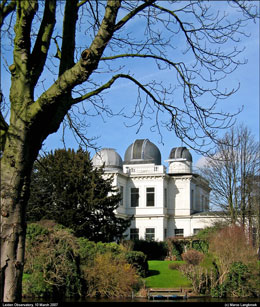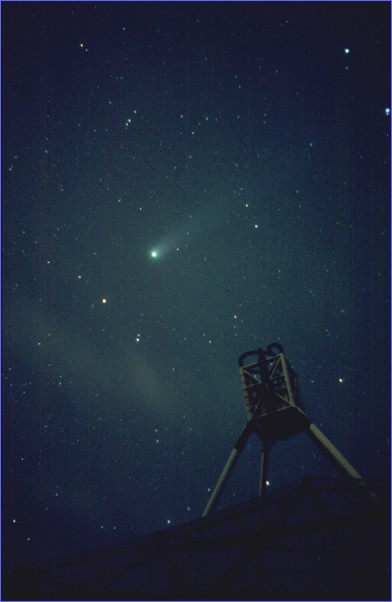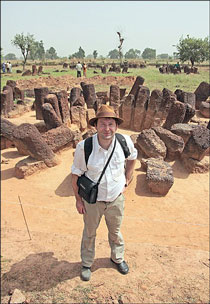|
Meet the ...
Interview with Marco Langbroek
A scientist with heart and soul
He started to learn about the secrets of the universe along with learning the
alphabet, and astronomy became his lifelong hobby, but not his profession. He
devoted many years to meteor astronomy, nowadays he prefers flyovers of artificial
satellites. He observes, records and analyzes with the same precision artifacts
from the Stone Age as well as the movement of spacecraft around the Earth.
Patient, persevering and keen observer, scientist with heart and soul.
Marco Langbroek.
The town of Leiden is a place where the oldest university in the Netherland is
situated. Many renowned physicists, including Nobel laureates worked at the
university and for a certain period Albert Einstein gave lectures there too.
Leiden is also your birthplace and hometown. Although you graduated here, your
subject had nothing to do with natural sciences. What is your profession, your
day time job?
I am an archaeologist, specializing in the Palaeolithic: the archaeology of our
earliest ancestors. Think Neandertals, handaxes, that kind of stuff. I got my MA
and PhD in Leiden, have worked as a field archaeologist for two municipal
archaeological services and now work as a post-doc researcher at the VU University
in Amsterdam.

Foto: M.Langbroek
The former home of Ehrenfest where Einstein used to stay, a large now somewhat
dilapidated white house is not far from my home by the way, and so is the old
Observatory of Leiden. The latter is some 300 meters from my home.
As an archaeologist you are digging for relics of the past, but early in your
childhood you turned your searching look at the opposite direction, to the sky.
How did you discover astronomy?
My interest in astronomy started around 1976, when I was 6 years old. I had seen
broadcasts about the Viking landers on Mars, and then my parents bought a book
about the planets. It interested me, and when my parents noticed the interest
was staying, they made me a member of the Dutch Youth Association for Astronomy
(JWG) late 1978. In 1979, when I was 9, I built my first telescope, a 6 cm
refractor with a good achromatic lens and rainpipe tube under the guidance of
people of that club.
You were a passionate stargazer in your youth. Have you ever thought to be a
professional astronomer?
I always wanted to study astronomy, but I never was very good in mathematics,
so by the end of highschool I had to let go of that idea. I have always been
interested in history as well, so considered history as a study. Archaeology
sounded slightly more adventurous. So I choose archaeology and got my MA in
1998 and PhD in 2003.
Astronomy became one of my hobbies. The funny thing is of
course, that I would end up doing more or less both: astronomy and archaeology,
the one as a semi-professional amateur, the other as a professional. To my
archaeological colleagues, it is still very confusing when they discover that
I also have peer-reviewed astronomical publications on my name!
What were your favourite targets in the sky?

|
For several years I focussed on planets and deep-sky, first with the 6 cm, later
with a 4" Newtonian I bought from money I saved from the money my parents gave
me to buy schoollunches. I was quite active in the Youth Astronomy Association
at that time, became part of the editorial staff of its magazine 'Universum'.
At the age of 19 I was asked to fill a monthly column about deep-sky observing
with small instruments in Zenit, the largest Dutch astronomy magazine. I wrote
that column for several years. About the same time, my focus started to shift
however, to small objects in the solar system: comets, and meteors.
In the 1980´s there was an absence of big comets, none of them were bright enough,
and the return of "the old lady" 1P/ Halley was nothing extraordinary. Which
comets did you observe?
1P/Halley was my first comet, and I next observed some not too bright comets like
one of the Bradfield comets in '87 and a few others in the magnitude +4 to +7
range that appeared in the second half of the eighties. The absence of bright
objects untill Hyakutake and Hale-Bopp came along in the nineties was why I left
the field of comets again and switched to meteors. I actually searched for new
comets with my 4" Newton, visually, in the evening twilight sky for two years but
never found one.
You became a keen and very busy observer of shooting stars ...
From the nineties onwards, I completely turned to meteor astronomy. As a member
of the Dutch Meteor Society, I took part in large observing expeditions that
covered the Leonid outbursts of the nineties and early 2000's. It took us all
over the globe: Spain (1995, 1999, 2002), France (1996), Portugal (2000), the
USA (2001), and of course the Mother of all Expeditions: Northwest China in 1998,
a cooperation with the Chinese Academy of Sciences and NASA. That was very special:
observing the 1998 fireball outburst at -23 C and 3.5 km altitude from a remote
high desert on the edge of the Tibet-Qinghai plateau.
Foto: M.Langbroek
What did awake your interest in meteors?
In 1989, on an open day at the Leiden Observatory where the local chapter of our
Youth Astronomical Association volunteered, I met Peter Jenniskens. He has
played a major role in how my career as a high-level astronomy amateur took shape.
At that time he was a PhD in astronomy in Leiden and starting up his work in
meteor astronomy. He was my mentor in meteor work, and guided me into semi-professional
observing activities. As a result, I now have authored or co-authored several
peer-reviewed papers on meteor astronomy. Peter left the Netherlands in 1992
for NASA's Ames Research Center and subsequently became a well-known meteor
astronomer.
He is the person who organized the big NASA Airborne Campaigns with aircraft
with equipment during the Leonid meteor storms, and who organized the expedition
that recovered the first fragments of the 2008 TC3 asteroid impact in Sudan.
I owe much of what I have accomplished as a high-level amateur astronomer to him.

|
The meteor work had some spin-offs, partly because I have a very broad interest
which often makes me explore new issues. I started collecting meteorites (and
now have a nice collection of these, plus impact glasses and impact crater breccia),
and my interest in meteoric fireballs led to spin-off interests in asteroids
and satellite decays.
Meteor observation requires a lot of time, which is limited only to night hours.
How could you share your time for study and meteor observations, especially
during your expeditions around the world?
In my twenties I was a good multi-tasker. And when I was doing my PhD, I planned
my hollidays to coincide with major meteor campaigns.
Around 2004, I became very ill. Doing big meteor campaigns became too stressful.
Later, after I recovered from my illness, my work started to take more and more
of my energy too. So I turned to the much less tiring and time-consuming (but fun!)
business of satellite observations around 2005. In fact, almost all of my current
observing activities concerns satellites: I am part of a small international
(and rather informal) network of observers that do position determinations, and
from that orbit determinations, of classified satellites. These observations are
done from my home in the Leiden town center, mostly using a DSLR camera, a suite
of lenses, and astrometric software that was originally developed to measure
multistation meteor images.
It was also the time when you started your participation on pro-am asteroid
collaboration ...
My work with asteroids indeed started around the same time. In 2004, a fellow
amateur (Jeff Brower) introduced me to the Spacewatch FMO project that used
volunteers to review photographic plates taken at Steward Observatory on Kitt
Peak for Fast Moving Objects (FMO): Near Earth Asteroids! It meant that over
many 2004-2006 mornings, I started the day by starting up my computer, logging
in, and inspecting several images taken the previous hours with the 0.9 m
Spacewatch telescope. I inspected over 3000 images before, on 2005 April 9,
this led to my discovery of the Amor asteroid 2005 GG81
You were not only one of the most persistent volunteer but also administrator of
the FMO mailing list. How could someone became such an administrator?
Stu Megan had set it up, but at a certain moment decided to stop. I then offered
to take up the effort and constructed a new mailing list, as I felt the social
contacts among the FMO people which the mailing list and forum enabled, were a
very good thing.
Another field where you participated very intensely was asteroid searches in the
SkyMorph archive. How did you get knowledge of it?
Partaking in the same FMO project, and soon in the social network that sprang
from it, Rob Matson was the person who introduced it to others. He is the second
person, after Peter Jenniskens, who has been very important to me in introducing
me to and guiding me into a particular field of semi-professional astronomy. Rob
learned me how to extract images from the Skymorph archive, work with Astrometrica
to measure them, and use Findorb to chase the new objects we discovered in the
archive, leading to more images on more nights, and eventually to designations
issued by the Minor Planet Center (MPC).
What was the reason for starting your hunt?
Reasons were that it is fun to do, and it helped me fill cloudy evenings and
rainy Sundays. When satellites remained hidden behind clouds, the internet NEAT
archives at Skymorph became my hunting ground... I have a scientific mindset.
Obtaining new knowledge and 'discovery' has always been the bread and butter of
my life: it is why I became a scientist. It is part of my profession, and part
of my hobbies. I explore, observe, record, investigate, analyse...: whether it
are stone tools, geologic outcrops, asteroids, meteor activity, satellites,
dragonfly species around a pond....that really is me. Curiosity, and an urge to
explore new frontiers. There is still so much to discover on this world, and
in our skies!
There is another possibility to make discoveries using internet, similar to FMO
Spacewatch project - searching for SOHO comets. This challenge did not attract
you at all?
No, and I can't quite explain why. Somehow, it isn't that attractive to me.
Maybe because it lacks the astrometry and recovery through orbit fitting
procedures (it is merely detecting something on a SOHO image and reporting it).
You discovered 58 minor planets in the NEAT archive, many of them now got a
permanent number and even several were named. What is your most highly esteemed
result from the SkyMorph hunt?
The three Jovian Trojan asteroids I discovered are special (2001 SD355; 2002 WV27;
2002 WG29). It makes me feel like I am modestly following in the footsteps of the
famous Van Houtens, the Dutch astronomer couple working at Leiden Observatory
who during the sixties and seventies discovered most of the Jovian Trojans, using
the same Palomar telescope that NEAT employs. My most special discovery is however
not from Skymorph/NEAT, but from the FMO project: 2005 GG81. I never forget the
morning I saw that little trail pop up on the image, and got the message back
from Spacewatch that it had been submitted to the NEOCP (Near Earth Object
Confirmation Page).
Later, when you mastered how to search for unknown asteroids you wrote a "Guide"
which was very helpful to other hunters, including myself. After you were guided
by Rob Matson, later you passed it on others. Was it a satisfaction for you when
asteroid (183294) got the name "Langbroek" in your honour?
I felt very honoured by it. And it is good to hear that the guide I wrote has
been of use to others. It means it served its purpose!
Although you started your asteroid hunt in the time when the MPC did no longer
credit discoverers itself (as it was earlier), but the NEAT programme, you could
name 7 of your discoveries. How did you feel when you proposed those names to
the MPC?
I felt privileged that I could honour several deserving people in this way. The
names I proposed so far, concern either long-active, high-level amateur astronomers
from the field of meteors, asteroids and satellites, or some of my professional
"heroes" from palaeoanthropology (Eugene Dubois and Lewis Binford). It feels very
good to be able to honour people you admire for their contributions in this way.
You traveled almost all over the globe to watch meteor showers, is there still a
place on Earth which you would like to observe the sky from?
I have been privileged to observe from many places on this planet: in the remote
Qinghai province of China; the Arizona desert; Senegal; the mountains of Spain
(even on Calar Alto in 1995) and Switzerland; the countryside of France, Spain,
Portugal, Germany, Denmark and the Netherlands. I would like to observe the
southern meteor showers and the Magellanic Clouds once from Australia. That is
one thing on my 'to do' list.
What is your favourite astronomy book?
A special one to me will always be Carl Sagan's "Cosmos", derived from the TV-series
of the same name. I watched the TV series as a boy in the early eighties, and
it heightened my already awakened fascination with astronomy even more.

|
In contrast to many archaeoastronomy "specialists" and certainly fringe people a
lá Erich von Däniken, you are a real expert in both, quite different sciences,
in archaeology and astronomy. What do you think about archaeoastronomical theories?
I must say that in most cases I am very critical of archaeoastronomical studies,
especially those done by astronomers rather than archaeologists. Many of those
studies go over the top, over-interpret chance alignments and ignore the wider
archaeological context. They also frequently try to picture prehistoric humans
as "scientists", as observational astronomers, and put much too much emphasis on
"calendar functions" etcetera.
But I believe many allignments on midwinter suns etc. were never made to be
actually observed: they were created for the symbolism of it (much like the
buried Viking ships in ship burials were never made to actually sail in).
And prehistoric humans really didn't need a stone sightline to determine it was
time to start plowing and sowing rye or einkorn: they would know that from other,
environmental clues. Meticulous time-keeping and observations on meridian transits
are merely obsessions of our modern time, where meticulous time-keeping is
important while at the same time we have lost, in our western urban society at
least, contact with the significance of signs like returning birds and the blossom
date of flowers.
What does astronomy mean to you?
It is a part of my life and lifeworld that will always be there. Nothing reliefs
stress more than lying on your back under a dark star-spangled sky, watching
shooting stars and the milky way. I can't resist looking up whenever the sky is
clear.
Every Schliemann searches for his Troy. Is that of yours still hidden beneath the
soil or revolving somewhere in the of deep space?
Who knows? The interesting thing about both astronomy and archaeology is that you
cannot properly predict what you will find. So who knows what is in store? Only
time will tell!
Leiden, Netherlands - Nové Zámky, Slovakia, 2011 Jan. 8
|

